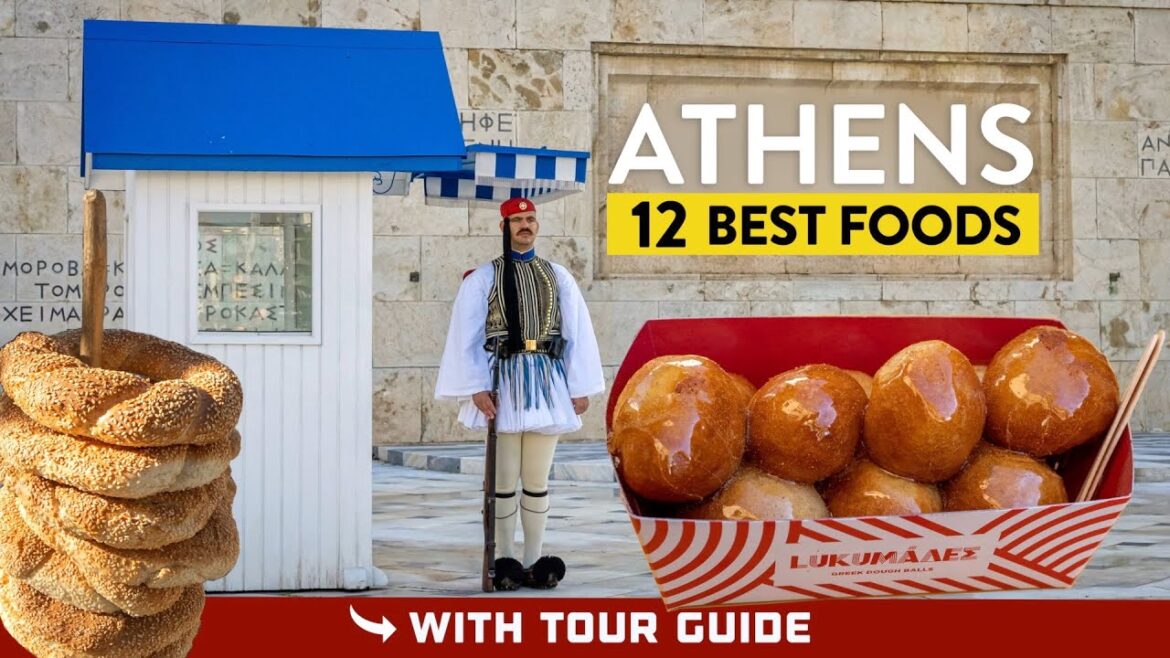What to Eat Local in Athens – This Post is a Collection of 2 Video Guides on Athens Street Food
Athens Food Tour Video Guide
Street Food Dishes Covered in the Video:
- Intro
- Koulouri
- Tiropita & Spanakopita
- Greek Coffee
- Souvlaki
- Loukoumades
- Anchovy & Sardine
- Taverns
- Tzatziki
- Zucchini Fritters
- Dolmades
- Moussaka
- Conclusion
Koulouri
One of the most humble yet beloved Greek street foods, Koulouri is a circular bread ring encrusted with toasted sesame seeds, often eaten for breakfast or as a quick snack on the go. Originating from Byzantine times, this crispy-on-the-outside, soft-on-the-inside bread is especially popular in Athens and Thessaloniki, where vendors sell them from metal carts on nearly every corner. Though it may appear simple, its flavor is subtly nutty and slightly sweet from the sesame, while the texture offers that satisfying balance between chew and crunch. Often compared to a bagel but airier and lighter, Koulouri pairs wonderfully with Greek cheese, olives, or even just a cup of strong Greek coffee. Some modern versions are stuffed with feta, olives, or sun-dried tomatoes, turning this modest bread into a filling meal.
Tiropita & Spanakopita
These iconic Greek savory pies are culinary poetry written in layers of golden, crispy phyllo dough.
- Tiropita, or cheese pie, is filled with a rich blend of feta, ricotta, and sometimes kasseri or mizithra, creating a creamy and tangy interior that contrasts deliciously with the flaky, buttery shell.
- Spanakopita, the greener cousin, brings together spinach, feta, herbs like dill and mint, and sometimes leeks or green onions, making it a more herbaceous, earthy delight.
Both pies are common in homes and bakeries and are equally suitable as a breakfast bite, an appetizer, or even a light lunch. These pies aren’t just food — they’re a connection to Greek heritage, often passed down in handwritten family recipes and lovingly folded for holidays and everyday nourishment alike.
Greek Coffee
Not just a beverage but a ritual, Greek coffee is brewed slowly in a briki (a small copper or brass pot) and served in a demitasse cup. It’s made with very finely ground Arabica beans, cold water, and sugar (if desired), all simmered gently until a layer of rich, foamy crema called kaimaki forms on top. Served without milk, this coffee is sipped slowly, often in a traditional kafenio, and always followed by reading the coffee grounds — a practice rooted in folk fortune-telling. Greek coffee culture emphasizes conversation, reflection, and social connection, where time slows down and a single cup can last an hour or more. The grounds settle at the bottom, so one learns to sip mindfully, savoring each bold, earthy mouthful.
Souvlaki
A cornerstone of Greek street food, Souvlaki refers to small skewers of marinated meat, typically pork, chicken, or lamb, grilled over charcoal and often served with warm pita, tzatziki, tomatoes, onions, and a sprinkle of oregano. In some regions, it’s wrapped like a sandwich (often confusingly referred to as gyro, though gyro meat is usually shaved from a vertical spit), while elsewhere it’s served skewer-only with lemon and sides. The marinade usually includes olive oil, lemon juice, garlic, and herbs, producing a juicy, tangy, and slightly smoky flavor. Souvlaki is the ultimate Greek grab-and-go food, loved equally by locals and tourists, and often enjoyed late at night after dancing or during festivals.
Loukoumades
Think of Loukoumades as Greek doughnuts with a mythic twist. These deep-fried dough balls, golden and crispy outside, fluffy and airy inside, are drenched in honey syrup, then dusted with cinnamon or crushed walnuts. They date back to Ancient Greece, where they were reportedly offered to winners of the Olympics as “honey tokens” — an edible medal of sorts. Today, they’re found in bakeries, festivals, and street stalls, often served piping hot. A bite into a loukouma is a burst of sweet nostalgia — sugary and aromatic, sticky-fingered and divine.
Anchovy & Sardine (Gavros & Sardela)
Though often overshadowed by trendier dishes, fresh anchovies (gavros) and sardines (sardela) are staple seafood offerings in Greece, typically grilled or marinated.
- Gavros marinatos — marinated anchovies — are cured in vinegar, then drizzled with olive oil, parsley, and garlic, yielding a delicate, almost buttery flavor that dissolves on the tongue.
- Grilled sardines, brushed with lemon and oregano, are simple but explosive in flavor, especially when eaten fresh by the sea with ouzo or retsina in hand. These tiny fish are a testament to the Greek ethos: fresh ingredients, minimal fuss, and maximum flavor.
Taverns (Tavernas)
To truly understand Greek food, one must experience a traditional taverna, the beating heart of the country’s culinary and social life. These family-run establishments, often decked out in blue and white, with wooden chairs and checkered tablecloths, serve food that’s as close to home-cooked as you can get. Taverns don’t just feed — they host, offering endless meze, slow-cooked stews, fresh catch of the day, and the kind of warm, leisurely service that invites you to stay long after your plate is empty. Here, meals are communal rituals, not mere fuel. You’ll often find live music, dancing, and a generosity of spirit that no guidebook can teach.
Tzatziki
No Greek meal is complete without Tzatziki, the creamy, tangy, garlicky yogurt dip that is as refreshing as it is flavorful. Made from strained Greek yogurt, cucumber, garlic, olive oil, vinegar or lemon, and often dill or mint, tzatziki is served cold and pairs beautifully with grilled meats, vegetables, or simply scooped up with pita bread. Its cooling properties make it a perfect complement to spiced dishes, while its bold garlic note ensures it stands its ground. In many Greek homes, tzatziki is a symbol of balance — where dairy, herbs, and acidity come together in perfect culinary harmony.
Zucchini Fritters (Kolokithokeftedes)
A staple of Greek meze menus, Kolokithokeftedes are zucchini fritters that are crispy on the outside, soft and fragrant on the inside. Made from grated zucchini, feta, fresh herbs like mint and dill, onion, and egg, they are lightly fried and often served with a dollop of tzatziki. The flavor is herbaceous and cheesy, with a subtle sweetness from the zucchini and a creamy saltiness from the feta. These fritters are often part of vegetarian mezze platters, ideal for summer meals by the seaside.
Dolmades
Dolmades are vine leaves stuffed with a mixture of rice, herbs, sometimes minced meat, and lemon juice, then simmered until tender. Found throughout the Mediterranean, the Greek version is often vegetarian, bursting with flavors of dill, mint, and olive oil, and served cold as a starter or hot as a main. The act of wrapping dolmades is itself a familial tradition, especially during holidays. Each bite delivers a harmony of citrusy brightness and deep herbal warmth, encased in a tender, slightly tangy grape leaf that’s been softened by time and steam.
Moussaka
Often called the king of Greek comfort food, Moussaka is a layered oven-baked casserole made with slices of roasted eggplant, ground meat (typically lamb or beef) in a rich tomato and cinnamon-spiced sauce, and topped with a creamy béchamel layer that becomes golden and slightly crispy when baked. The dish is hearty, aromatic, and deeply satisfying, embodying everything a Mediterranean meal should be: bold, layered, and soulful. Though variations exist (some include potatoes or zucchini), the essence remains the same — a dish that nourishes both body and spirit. Moussaka is often served during special occasions or Sunday family meals, where its slow-baked richness becomes the centerpiece of the table.


